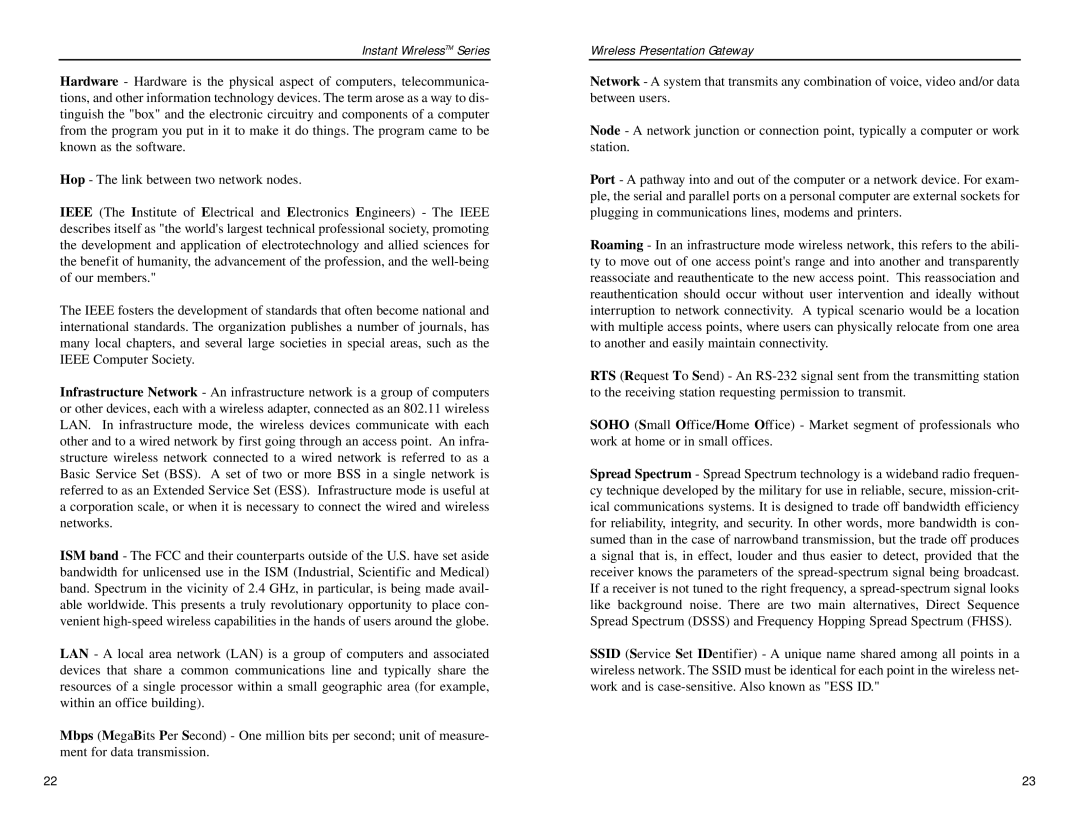Instant WirelessTM Series
Hardware - Hardware is the physical aspect of computers, telecommunica- tions, and other information technology devices. The term arose as a way to dis- tinguish the "box" and the electronic circuitry and components of a computer from the program you put in it to make it do things. The program came to be known as the software.
Hop - The link between two network nodes.
IEEE (The Institute of Electrical and Electronics Engineers) - The IEEE describes itself as "the world's largest technical professional society, promoting the development and application of electrotechnology and allied sciences for the benefit of humanity, the advancement of the profession, and the
The IEEE fosters the development of standards that often become national and international standards. The organization publishes a number of journals, has many local chapters, and several large societies in special areas, such as the IEEE Computer Society.
Infrastructure Network - An infrastructure network is a group of computers or other devices, each with a wireless adapter, connected as an 802.11 wireless LAN. In infrastructure mode, the wireless devices communicate with each other and to a wired network by first going through an access point. An infra- structure wireless network connected to a wired network is referred to as a Basic Service Set (BSS). A set of two or more BSS in a single network is referred to as an Extended Service Set (ESS). Infrastructure mode is useful at a corporation scale, or when it is necessary to connect the wired and wireless networks.
ISM band - The FCC and their counterparts outside of the U.S. have set aside bandwidth for unlicensed use in the ISM (Industrial, Scientific and Medical) band. Spectrum in the vicinity of 2.4 GHz, in particular, is being made avail- able worldwide. This presents a truly revolutionary opportunity to place con- venient
LAN - A local area network (LAN) is a group of computers and associated devices that share a common communications line and typically share the resources of a single processor within a small geographic area (for example, within an office building).
Mbps (MegaBits Per Second) - One million bits per second; unit of measure- ment for data transmission.
Wireless Presentation Gateway
Network - A system that transmits any combination of voice, video and/or data between users.
Node - A network junction or connection point, typically a computer or work station.
Port - A pathway into and out of the computer or a network device. For exam- ple, the serial and parallel ports on a personal computer are external sockets for plugging in communications lines, modems and printers.
Roaming - In an infrastructure mode wireless network, this refers to the abili- ty to move out of one access point's range and into another and transparently reassociate and reauthenticate to the new access point. This reassociation and reauthentication should occur without user intervention and ideally without interruption to network connectivity. A typical scenario would be a location with multiple access points, where users can physically relocate from one area to another and easily maintain connectivity.
RTS (Request To Send) - An
SOHO (Small Office/Home Office) - Market segment of professionals who work at home or in small offices.
Spread Spectrum - Spread Spectrum technology is a wideband radio frequen- cy technique developed by the military for use in reliable, secure,
SSID (Service Set IDentifier) - A unique name shared among all points in a wireless network. The SSID must be identical for each point in the wireless net- work and is
22 | 23 |
